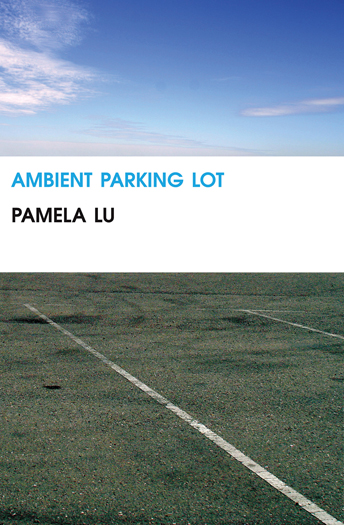
by by Margaret Kolb

Published by Kenning Editions, 2011 | 200 pages
In January 1975 Brian Eno was hit by a taxi cab. At the time, he was best known as the ex-synthesizer player for the glam-kitsch band Roxy Music, though he would eventually be known for producing Talking Heads, Devo, and U2, among others. He had put out a few critically acclaimed solo records - largely in the rock mold - and, the night he was hit, was returning home from the studio. The accident left him immobile and stuck in bed. In the liner notes to one of his next records, Discreet Music, he describes what happened during his convalescence:
My friend Judy Nylon visited me and brought me a record of 18th century harp music. After she had gone, and with some considerable difficulty, I put on the record. Having laid down, I realized that the amplifier was set at an extremely low level, and that one channel of the stereo had failed completely. Since I hadn’t the energy to get up and improve matters, the record played on almost inaudibly. This presented what was for me a new way of hearing music—as part of the ambience of the environment just as the color of the light and the sound of the rain were parts of that ambience.Thus Eno recounts how he came to invent “ambient” music (he also coined the name). Ambient music did, of course, have a classical music forerunner in the musique d’ameublement (literally, “furniture music”) of Satie—small tinkling sketches meant to decorate a room — but Eno introduced that minimalism into the context of rock. This would prove profoundly influential as, to give just one example, ambient music would affect a shift from the songs-as-pieces-of-the-album’s-larger-whole format that most listeners were familiar with. Instead of emphasizing the song, or even the album, ambient music emphasizes the experience of music, the feeling of music, the listening.
Today, ambient music is everywhere, from art galleries to banner ads on the home page of the Wall Street Journal. While this turn has largely been looked at positively, especially in light of its use in the decoration of public spaces (and, really, who can object to a new form of art?), what if we were to suspend the music in its genesis, and examine it there? What does ambient music -- as music of Eno’s enforced, cerebral solitude -- look like? Asked differently, how much time can we spend by ourselves in our rooms?
*
“Actually, I’d grown somewhat dissatisfied with my role in that community,” says an unnamed Dancer in the penultimate chapter—which takes the form of a Terry Gross style interview—of Pamela Lu’s Ambient Parking Lot. The Dancer is discussing her involvement with her local art scene as a preamble to her artistic rebirth—her first meeting with the hilariously named band, The Ambient Parkers.
The Ambient Parkers are the main characters of Lu’s book—an ambient music band that makes a career of recording the parking lots of different American cities. The book follows the band’s early stumblings and breakthroughs in content and performance as well as its concerns over money and career direction. The band (and the book) gets sidetracked by a long critique from a station manager at a pirate radio station until, finally, they’re accepted by the pop music community.
Most of the book is narrated by the Ambient Parkers, who take a 1st person plural that apes, perhaps, the avant-garde manifesto by way of The Breakfast Club (this is not meant as disparagement). Hilarious and wistfully Romantic, Lu’s Ambient Parkers are familiar to anyone who has lived in a small college town with as many parks as parking lots, anyone who’s read the fliers at the co-op:
We slipped underground and regrouped to discuss proper ambition. After several cycles of soul-searching, we deemed ourselves ready to produce a full length album. We purchased sturdy walking shoes and took only public transit in order to develop rigorous objectivity vis-à-vis our subject matter.Lu excels at this type of aesthetic language, and the book hangs on the simultaneously earnest and absurd progression of the Ambient Parkers through different descriptions of their acts while they continue to simply make ambient recordings of parking lots.
Lu uses this story as scaffolding upon which to layer analyses of listening, creation, etc. Her book is never a satire. Her characters engage in the sincere attempt to escape the passive acceptance of their inherited surroundings. Eno couldn’t get up from his bed to change the volume; how can Lu’s musicians both faithfully record and positively affect their surroundings? How can we respect the parking lots (and strip malls and old highways and dilapidated city centers and...and...) while transforming them into something different?
Because of the constancy of the Ambient Parkers’ plural “we” throughout the book, the encroachment of the Dancer’s singular “I”—“I’d grown somewhat dissatisfied”—is an estranging point in the book that acts both as a natural-progression-of and meta-commentary-to the pluralistic fantasies the Ambient Parkers hold. The Dancer, now famous for reasons I won’t go into here, had been an early collaborator on one of the Ambient Parkers’ hybrid performances that took place in the lot of an abandoned manufacturing plant. The Dancer’s interview satirizes the career-band member stepping out from the shadows, but also introduces a new aesthetic language into the conversation—that of the embodied performance artist. “I wanted them,” the Dancer says of the band, “to acknowledge their underlying wickedness and embrace it, because as you know, you have to be a little wicked to carry off this kind of art.”
The Ambient Parkers describe her dance: “Enacting the plight of a disaster victim, [the Dancer] placed herself inside the wreckage of a crushed vehicle. With her arms wedged against her chest, she conjured up a pathos of immobility.” Contorted within the car, the dancer slowly—over a quarter hour—pulls a phone out of her pocket and begins dialing for emergency help. No one answers or offers help. Through all of this:
Her solitude was consummate and philosophic, that of a lone survivor in a parking lot marked for death. As she punched in the numbers, the space between her fingers, the phone, and the wreckage was filled in with ambience, a covert backdrop of collective amnesia and white noise impeding her efforts to secure voice contact with a savior.The Dancer’s movement furthers the Parkers’ inquiry into their environment but shifts the activity from the collective to the individual through the polite schism her language makes with that of the Parkers. This is one way Lu’s book looks at the cerebral struggle of artmaking and of ambient music: as struggle between the problems of the language of individual and the language of the collective. What to do with the parking lots flips into what to do with the disaster victim? How can we transform the highways becomes how can we give automobile drivers a secure voice?
*
Judy Nylon—Brian Eno’s friend with the hard music—tells a slightly different version of the origin story of ambient music in Geeta Dayal’s book on Eno’s album Another Green World:
“The room was grey, the carpet was grey, the light was grey,” Nylon remembered. It was pouring rain. Nylon bought a tape of harp music for [Eno] from a street vendor. She wasn’t much into harp music—Eno wasn’t a particular fan either—but she thought, based on her own childhood experiences, that the mellifluous instrumentals might help. She put it on the stereo at a low volume and tried to balance it with the sound of the rain. Eno caught on to what she was doing, and leaned over, helping to balance the soft music with the sound of the pitter-patter of the raindrops. Eno’s fabled ambient-music wasn’t an accidental mistake; it naturally flowed from the setting.There are two main differences in Nylon’s version of the story. First, Eno was clearly an active participant working with Nylon to make the music happen. Second, as Dayal succinctly puts its: “[the music] naturally flowed from the setting.” Ambient music comes to be from the actions of two people—Brian Eno and Judy Nylon—forgotten when reading Eno’s heroic version of the story. In its quiet yet grand statements about creativity, community, and individual practice, Ambient Parking Lot abstracts this conversation between the singular, immobile creator and the communal creation, projecting it onto a canvas of small acts of comfort.
Devin King is a writer, musician, and teacher working in Chicago, IL. His long poem, CLOPS, is out from the Green Lantern Press, Chicago. More at http://dancingyoungmenfromhighwindows.com.















click to see who
MAKE Magazine Publisher MAKE Literary Productions Managing Editor Chamandeep Bains Assistant Managing Editor and Web Editor Kenneth Guay Fiction Editor Kamilah Foreman Nonfiction Editor Jessica Anne Poetry Editor Joel Craig Intercambio Poetry Editor Daniel Borzutzky Intercambio Prose Editor Brenda Lozano Latin American Art Portfolio Editor Alejandro Almanza Pereda Reviews Editor Mark Molloy Portfolio Art Editor Sarah Kramer Creative Director Joshua Hauth, Hauthwares Webmaster Johnathan Crawford Proofreader/Copy Editor Sarah Kramer Associate Fiction Editors LC Fiore, Jim Kourlas, Kerstin Schaars Contributing Editors Kyle Beachy, Steffi Drewes, Katie Geha, Kathleen Rooney Social Media Coordinator Jennifer De Poorter
MAKE Literary Productions, NFP Co-directors, Sarah Dodson and Joel Craig